KING
- Taylor Joe Berger

- Apr 1, 2022
- 9 min read
Updated: Apr 19, 2022
Ever since Florence + The Machine came out with their very first full-length album Lungs (2009), they have been creating dreamy, otherworldly visuals alongside their unique and equally grand sound. Be it the charming DIY video for "Dog Days Are Over" or an entire film project split into chapters as seen in her The Odysse series (2016), which holds one of my personal favourites of theirs (speaking musically and visually) "St. Jude". Clearly Florence Welch is as much a visual artist as she is a songwriter and vocalist. She did after all briefly go to Camberwell College of Arts before fully focusing on her music career. In this blogpost, I am going to explore what possible inspirations and references were gathered to create this most recent video by Florence Welch and director Autumn De Wilde: KING.
Of Kings, Snails, And Mothers
The video starts with the word KING across the screen in a dark royal purple. An agitated man is sitting in an abandoned-looking office building. The shelves are empty and placed randomly as if most of the interior had been moved out already. The floor, columns, and ceiling are stone/cement maybe even marble. The walls are made up of very large windows letting in a lot of light from the left side of the frame. The light and the shapes on the ceiling convey a kind of sacred or chapel-like ambiance.
The man, clothed completely in black is upset. The camera moves towards him, revealing a figure in the background in a royal purple cape, previously hidden by a column. This reveal is underlined by a haunting sound; a gasp for air. A close-up confirms: This is Florence.
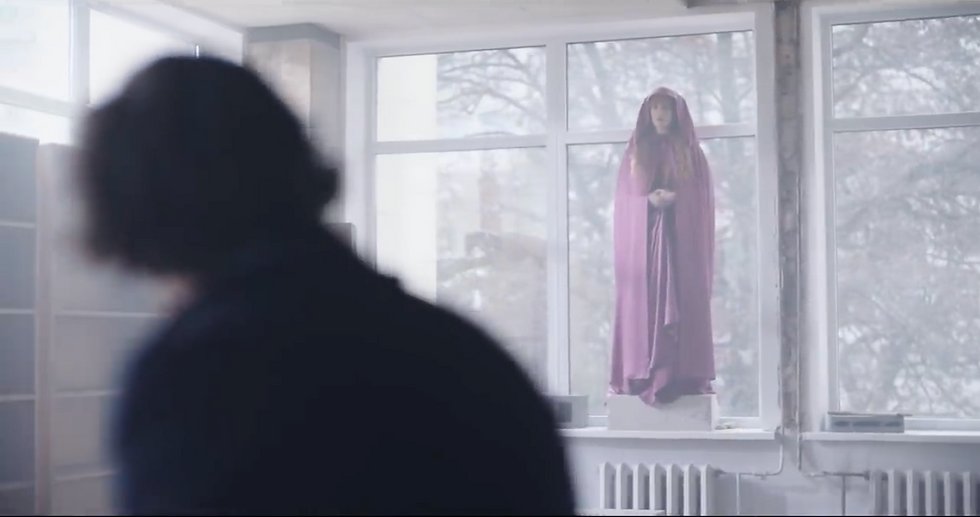
(Still, Florence Welch in "King", 2022)
Standing still, hands folded, surrounded by bright light, she is placed on top of what appears to be a brick of marble, making her a statue of sorts. Her placement, garment and pose reminiscing paintings and sculptures of the Holy Mother Mary. Mater Dolorosa explicitly depicts the always worrying restless mother. Pietà, the mother grieving over her son. The bright light completes this serene image and makes it even more sacrosanct. The colour purple indicates high rank, be it in a religious or royal context as this pigment, made from the shells of marine snails (Hexaplex trunculus, Bolinus brandaris, and Stramonita haemostoma), was considered to be the rarest and most expensive.
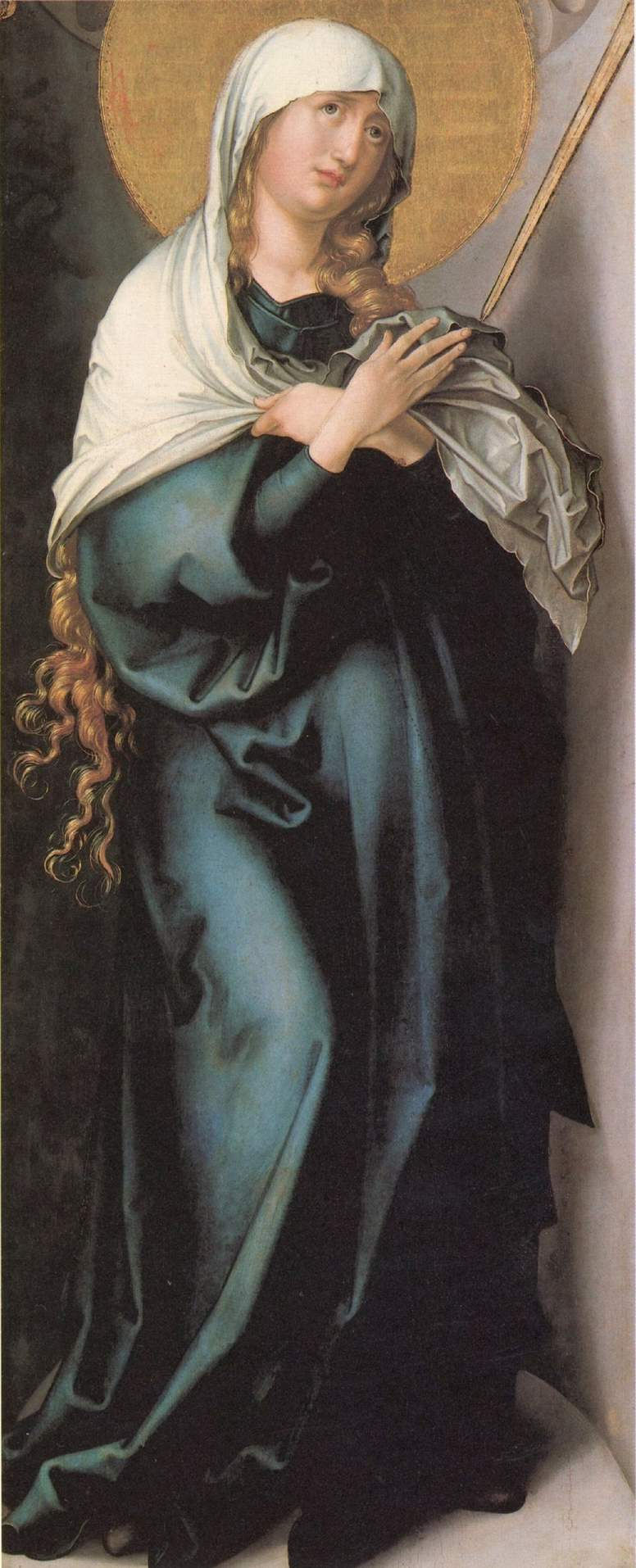
(Painting, Albrecht Dürer, Die Schmerzensmutter, 1495/98)
Florence seems calm, indifferent. The words leaving her lips are extremely potent, she remains statuesque. After singing "I am no mother, I am no bride, I am KING", she seems to be slowly released from her so far fixed position, as we see more and more movement in her body. There is a tension between what was earlier described as Holy Mary imagery and the very harshly contrasting lyrics:
"I am no mother…" The man feels a presence behind him, horror covers his face, he turns around to see Florence now floating outside, opening the window, therefore entering his space and with one gesture commanding him across the room into her arms.
"I am no bride…"
She holds him in an affectionate but also threatening embrace and together they fly upwards in a straight line.
"I am… KING"
On the word King, we hear the cymbal and a brutal crack, enhanced by the "K" in King as Florence snaps his neck. Now wearing a smirk, as she took his life with one swift move. Florence seems invigorated by this as we see her breath in the now dark cool night air while her victim remains still. A third character is revealed standing below the scene, facing away. A young man also clothed in black, his breath reveals he is alive. His demeanour is focused but he also seems nervous.

(Still, Florence Welch in "King", 2022)
Catch A Breath
Familiars are believed to be spirits assisting witches in their magic. Often, they are depicted as animals, such as a black cat or a toad, but they can also have a human form. A common name for them would also be demons or fairies, depending on whether they are considered malevolent or benevolent. More recent definitions of familiars would be mortals assisting immortal beings in hopes of receiving some sort of magical education or even the secrets to immortality. An example for this would be the relationship between a vampire and his familiar. The familiar works for their master for the promise of being turned, thus also becoming immortal. Perhaps this new character following Florence throughout the video but remaining very passive and docile could be a sort of familiar to her, which would make her a witch, vampire, or immortal being of sort.
"What strange claws are these"
She sings with a confused look on her face, is she coming into her own power? We see her leading the way, still floating above the ground, the dead man floating behind her, and the familiar walking at the end.
"I am no mother, I am no bride, I am King"
This time around in a more sinister, seducing, dark voice, quietly confident.
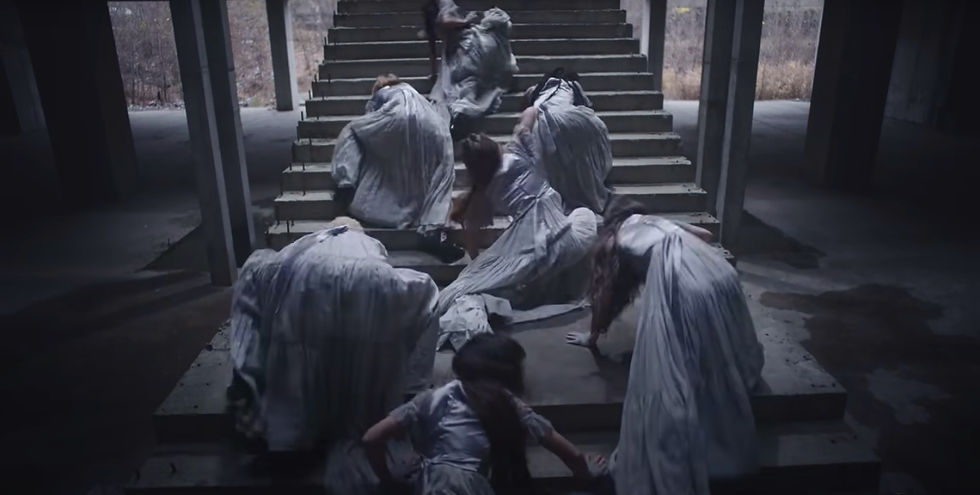
(Still, Florence + The Machine, "King", 2022)
We cut away to what looks like undead bridesmaids crawling up a large flight of stairs. Now in a huge, brutalist building, hollowed out, empty, only a skeleton of what it was, nevertheless appearing sacred. This shot reminiscent of any zombie movie. This seems fitting since folklore around zombies and vampires started with the term 'undead' and described a being awakening in their grave eating away at their own flesh. It was believed that as long as they had something to eat misfortune would come to the relatives of the deceased and the people living close to the cemetery. This belief encouraged people to preventive staking of the corpses before burying and other gruesome practices. Vampires and zombies alike derive from such stories, more and more elaborate details were added to the creature over time, that would end up being the death-bringing, youthful, seductive vampire, often hyper-sexualized as the stories around them reached their height in popularity and fascination during a very strict, religious and therefore prude time. The tales surrounding vampires enabled people to express their phantasies and demons without claiming them to be their own, as it was said that if vampires found an interest in you they would often find you in your dreams, speak to you, seduce you before paying you a deadly visit. Not uncommon were stories of female vampires who would prefer women, claiming them as lovers before giving them their final kiss.
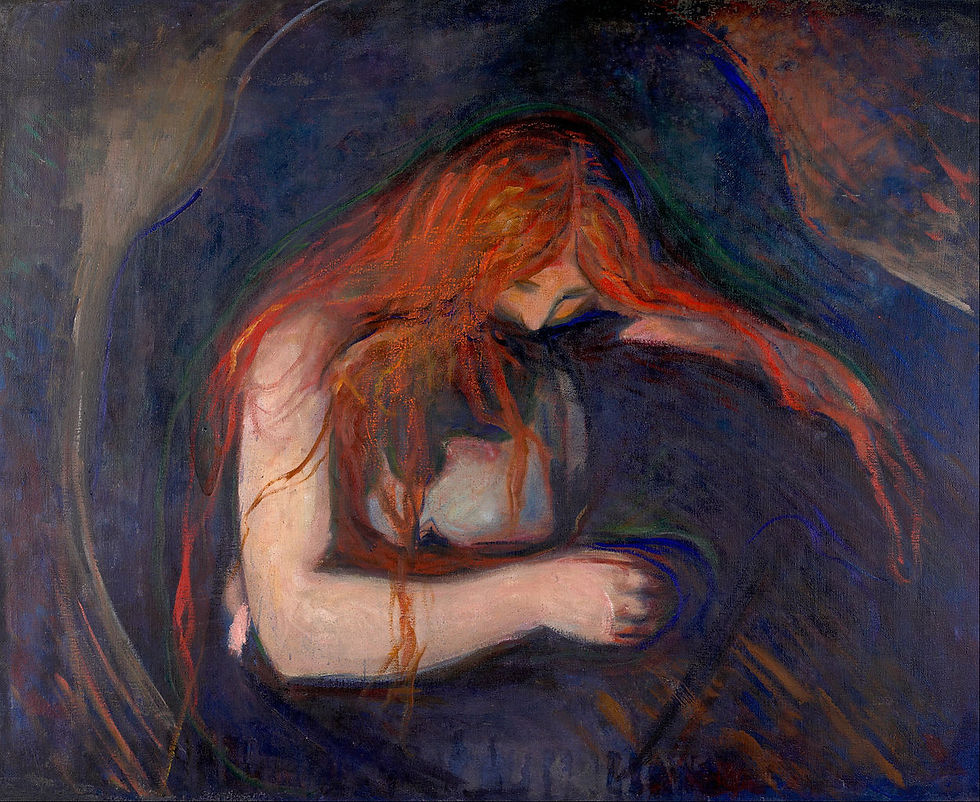
(Painting, Edvard Munch, Vampire, 1895)
The women in their lavender dresses are also wearing a sort of ring around their necks, perhaps suggesting previous imprisonment or a collar left from a domestic cage? They gather around Florence, who leads them into doing a simple choreography: "I am no mother", swaying from left to right holding their stomachs, "I am no bride", folding their hands in prayer, still ducked and with small posture, "I am King", now closing their right fists and standing tall.
Break The Circle
Florence's vocals fall back, become softer, quieter and the music fades… A small rumble of a drum remains, the young women gathered around in a circle, fists still in the air, faces torn by their wide-open mouths as they scream in silence. A drum roll hits and Florence’s voice soars through the track! Still reminiscent of Pietà while her 'disciples' go crazy around her, pulling their skirts, stomping around, revealing snarling faces whilst prancing about.
Florence suddenly breaks loose from within the circle with a firm step heightened by the enormous sound of the song. The heaviness seems to disperse and in its place, there is exhilaration and joy.

(Still, Florence + The Machine, "King", 2022)
The young women now in formation are circled by Florence in what only can be described as a kind of initiation ritual. Perhaps these young women are next in line to receive their powers, similar to what is described in pagan traditions as the Witches' Sabbath. These were secret meetings and celebrations held between witches, sorcerers, and the devil where they would scheme and plot for the coming year. The ritual was believed to be held on the turn of spring, announcing the change of the season.
The music and the scenery calm down. The great cement wall as a backdrop now is smeared with pink. Floating in the very centre of the composition we have the sorceress conducting a band which appears to be made up of previous victims. All men dressed in black. All petrified in mid-air, together forming an arch. Her latest victim hovering next to the familiar. The other women are now dancing in a more controlled and slowed-down fashion, turning on the spot.

(Still, Florence + The Machine, "King", 2022)
Suddenly back where it all started, we see the scared expression of the previously dead man. But this time around Florence is standing on one of the remaining desks in the office. In a very blurry frame, we see the silhouette of the man on the right. And for a second, also blurry, the lights flicker and fail soon after as the image becomes clearer. Was this a sign? A warning? The lights signalling the end of the illusion? As in film daydreams and such mostly are disrupted by an intrusion of sorts, a loud car or a ringing telephone for example, perhaps this flicker of the lights functions in a similar way.
The man hurries to Florence, seeking refuge, comfort in her arms. She caresses his face, bends over him to presumably kiss him, but the fabric of her cape and hood swallows him as we once again hear the unnerving sound of her sucking in the air. The man is consumed by her.
Was this all a dream? A hallucination? This is where we delve into the myth of the Boo Hag. Often compared to vampires, the Boo Hag is a creature that shares many similarities with them yet does not feast on their victims’ blood but breath. Often, they would sit on their victim while they were asleep and bring them chest pains and nightmares. A symptom often described in sleep paralysis. It is also said that they wore the skin of others since they did not have one of their own, therefore being red as their flesh was exposed, perhaps the allusion is signified by the red dress Florence is wearing underneath her cape?
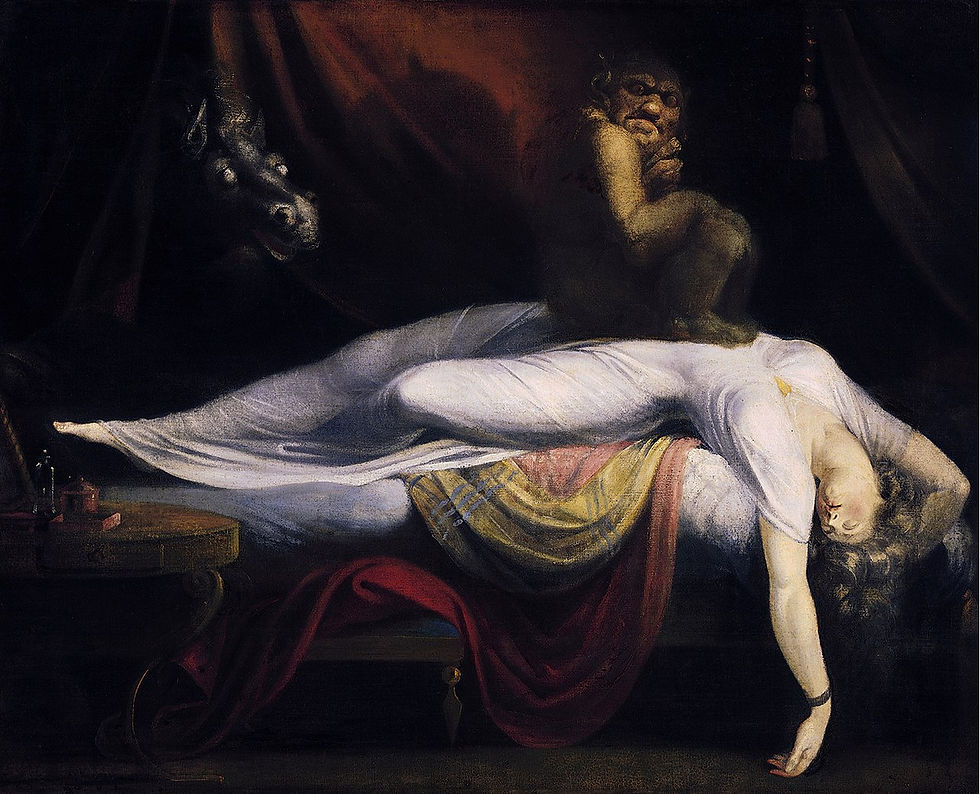
(Painting, Johann Heinrich Füssli, Nachtmahr, 1781)
Another creature, however, unlike the Boo Hag from around South Carolina, originated in eastern Europe; The Nachtalb also called Nachtmahr is said to follow a similar hunting pattern but has a much more animalistic appearance. Florence has clearly referenced this very beast before, presumably quoting a painting by Johann Heinrich Füssli called Nachtmahr, in her video for "Delilah". It appears as if the being she portrays here can not be pinned down to one specific thing.
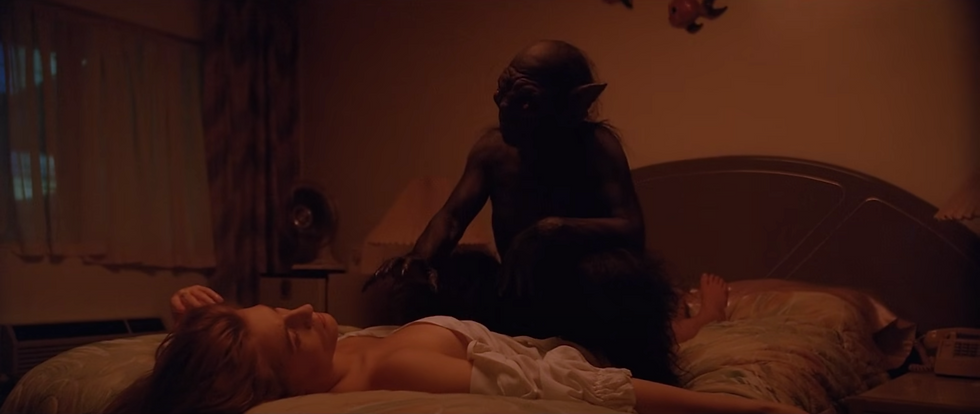
(Still, Florence Welch in "Delilah", 2015)
A Lost Battle
The opening scene and the end show a crushed man in an office building dressed in unremarkable black clothing. This kind of workplace is battle-field and throne room alike to the 'Kings' of our age. This very well might be all that is left from a lost battle. Cleared out office space, empty bookshelves, and a broken man still in rage after losing his stance, maybe his identity even. It seems even more poignant to witness the many expressions moving across his face as he tries to listen to what Florence has to say. After hearing the words "I am no mother" he immediately loses interest and respect for her. These very small understated but very articulate moments throughout the video give it a power and show an innate understanding of the issues and emotions addressed in the song.
"As an artist, I never actually thought about my gender that much, I just got on with it… Thinking about being a woman in my 30s and the future, I suddenly feel this tearing of my identity and desires. That to be a performer, but also to want a family might not be as simple for me as it is for my male counterparts… I have to make decisions they did not." – Florence Welsh
This statement accompanying the release for the single and video, has been picked up by many online outlets to describe the themes explored in the project. However, it seems lazy to imply this is all we see and hear. There is a complexity and ambivalence within the song and video, which often goes missing when trying to portray these nuanced, systematic issues surrounding gender in a single music video.
What if this depiction of Florence as a powerful otherworldly being is also another commentary on a long-standing tradition of mystifying the 'elusive female'? The apparently inherently chaotic, treacherous and seductive? A male perspective to which women have been subjected to. A very clear example would be the witch hunts for instance, where predominantly women were accused of such sorcery for several reasons. Perhaps the accused lived alone, did not want children, didn’t have children, had too many children, or not enough. Maybe she had too much money or simply had red hair. In any way, shape, or form a woman would stray away from what was expected to be her role in society, she would immediately be punished for it. This included burning at the stake or more often be hung. Whereas the fewer men accused of sorcery were always suspects solely for being associated with already sentenced women. So, are we witnessing a woman coming into her own powers in the video? Or are we seeing what this broken man fears women to be? Is there blame placed on her instead of acknowledging his own shortcomings? Does he believe to end up paralyzed, cold and dead, if she were to have her own way? The end would suggest we witnessed his imagination, his dream perhaps, as he stands there, alive, even relieved to see Florence this time around standing on a desk. Has he gotten away with it? Only to then be fully consumed by a short haunting breath?

(Still, Florence + The Machine, "King", 2022)
I refuse to believe that any kind of fever-dream would be so articulate. We would not see Florence in such a forgiving light. She killed a man on screen, yet we are far from thinking of her as evil because of it.
Perhaps trying to pin any of this down, grabbing it, and trying to contain it in concrete is pointless as this specific and again ambivalent lyric suggests:
"But a woman is a changeling, always shifting shape
Just when you think you have it figured out something new begins to take"
She is not and never was one thing…



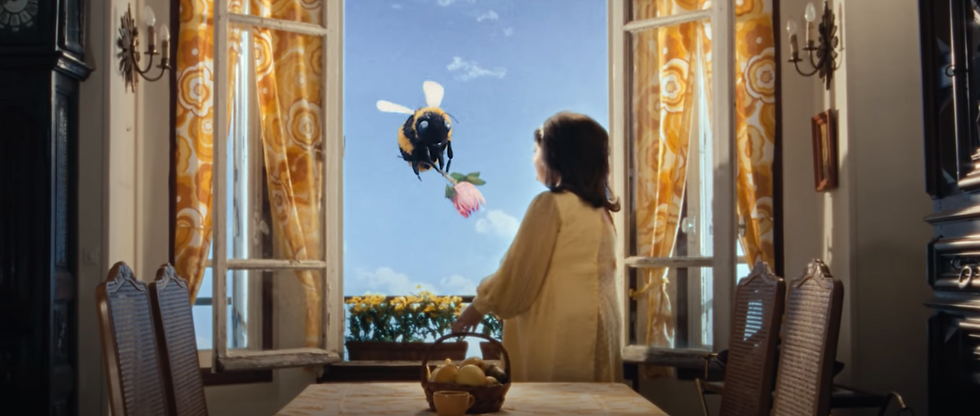


Comments